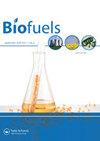Influence of graphene oxide nanoparticles dispersed mahua oil biodiesel on diesel engine: performance, combustion, and emission study
IF 2.6
4区 工程技术
Q3 ENERGY & FUELS
引用次数: 1
Abstract
Abstract The present study addresses the effect of graphene oxide (GO) nanoparticles dispersed in a mahua biodiesel blend (B20) on diesel engine performance, combustion, and emissions. GO nanoparticles were considered at a level of 75 mg/L. Also, the surfactant CTAB and dispersant Tween 80 were added in a 1:1 ratio. Stability analysis was performed using a photospectrometer. The injection pressure was varied from 200 to 250 bar. The performance parameters such as brake thermal efficiency (BTE) and brake specific fuel consumption (BSFC) were improved by dispersing nanoparticles in B20. Combustion characteristics such as cylinder pressure (CP) and net heat release rate (NHRR) were also greatly improved by nanoparticle dispersion. Finally, emissions of carbon monoxide (CO), unburned hydrocarbon (UHC), smoke, and nitrogen oxides (NOx) were greatly reduced. The dispersant-added GO nanoparticles showed exceptional results. At 250 bar, the B20 + GO 75 mg/L + Tween 75 mg/L showed a 5.067% improvement in BTE and a 6.293% reduction in BSFC. In addition, CP and NHRR were improved by 3.13% and 43.85%, respectively. Finally, reductions in CO, UHC, NOx, and smoke opacity were found to be approximately 27.77%, 37.63%, 11.07%, and 38.55%, respectively.纳米氧化石墨烯分散的马华油生物柴油对柴油机性能、燃烧和排放的影响研究
本文章由计算机程序翻译,如有差异,请以英文原文为准。
求助全文
约1分钟内获得全文
求助全文
来源期刊

Biofuels-Uk
Energy-Renewable Energy, Sustainability and the Environment
CiteScore
5.40
自引率
9.50%
发文量
56
期刊介绍:
Current energy systems need a vast transformation to meet the key demands of the 21st century: reduced environmental impact, economic viability and efficiency. An essential part of this energy revolution is bioenergy.
The movement towards widespread implementation of first generation biofuels is still in its infancy, requiring continued evaluation and improvement to be fully realised. Problems with current bioenergy strategies, for example competition over land use for food crops, do not yet have satisfactory solutions. The second generation of biofuels, based around cellulosic ethanol, are now in development and are opening up new possibilities for future energy generation. Recent advances in genetics have pioneered research into designer fuels and sources such as algae have been revealed as untapped bioenergy resources.
As global energy requirements change and grow, it is crucial that all aspects of the bioenergy production process are streamlined and improved, from the design of more efficient biorefineries to research into biohydrogen as an energy carrier. Current energy infrastructures need to be adapted and changed to fulfil the promises of biomass for power generation.
Biofuels provides a forum for all stakeholders in the bioenergy sector, featuring review articles, original research, commentaries, news, research and development spotlights, interviews with key opinion leaders and much more, with a view to establishing an international community of bioenergy communication.
As biofuel research continues at an unprecedented rate, the development of new feedstocks and improvements in bioenergy production processes provide the key to the transformation of biomass into a global energy resource. With the twin threats of climate change and depleted fossil fuel reserves looming, it is vitally important that research communities are mobilized to fully realize the potential of bioenergy.
 求助内容:
求助内容: 应助结果提醒方式:
应助结果提醒方式:


